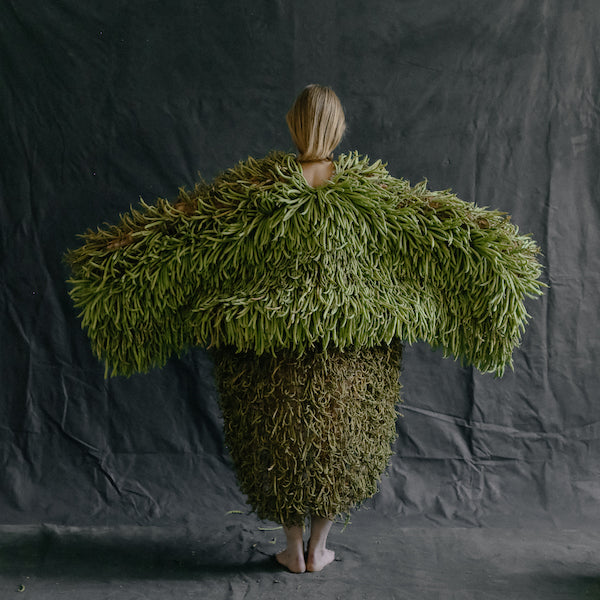
Let it Grow! Deborah Eydmann Talks Biotextiles With Atelier Dasha Tsapenko
From couture to carpets, collaboration is a key ingredient in Ukrainian designer Dasha Tsapenko’s practice. And she certainly has a wealth of partners to choose from, although perhaps not the type that usually springs to mind. Based in The Hague, in the Netherlands, Tsapenko combines traditional craftsmanship with innovative scientific research to grow garments, objects and narratives in concert with a multitude of living organisms.

Believing strongly in the capabilities of mycelium (the root-like structure of fungus) to ‘co-produce’ alternative biomaterials for a more regenerative future, Dasha’s Atelier investigates the intersection of fashion and agriculture, among other things, often working between a microbiology lab and a farm, to develop sustainable concepts, products and techniques using self-grown flexible matter as a medium. Natural cycles and rhythms guide and frame her practice, which involves growing, harvesting and hand-processing surfaces before artfully transforming them into ‘MYC’ garments, tapestries, tablecloths and rugs with real functional and aesthetic value. Tsapenko’s - and Mycelium’s – appetite for innovation is insatiable...
Deborah Eydmann: How did you evolve from architecture and design to growing bio-based clothing/textiles/objects?
Atelier Dasha Tsapenko: The format of a garment as an outcome and medium for almost any type of assignment came during my architectural studies in Ukraine. Later, when I did my Masters in Social Design in Eindhoven, I explored the connection of the human and the domestic space through various actions connected to clothes.
In parallel, I was introduced to the possibilities of Biodesign through European biomaterial pioneer Eric Klarenbeek. During my residency at Jan van Eyck Academie in Maastricht, I realiSed that the daily action of taking care (providing water to the plant) can be a powerful design tool.
The full shift took place while I was working in the microbiology lab of Utrecht University together with Prof. dr. Han Wösten, as part of the Bio Art and Design Award project, which we won together. We explored how we could create and use garments by applying the principles of agriculture.
Want to read more of this article?
We are proud to be a subscriber-funded publication with members in 185 countries. We know our readership is passionate about textiles, so we invite you to help us preserve and promote the stories, memories, and histories that fabric holds. Your support allows us to publish our magazine, and also ‘what's on’ information, and subscription interviews, reviews, and long-read articles in our online blog.
ALREADY A SUBSCRIBER? CLICK HERE TO ACCESS CONTENT
OR...to continue reading….

*Magazine subscribers automatically get free access to all our online content. We send the access code by email with the publication of each issue. You will also find it on the envelope containing your magazine. Please note the access code changes every issue.*

Believing strongly in the capabilities of mycelium (the root-like structure of fungus) to ‘co-produce’ alternative biomaterials for a more regenerative future, Dasha’s Atelier investigates the intersection of fashion and agriculture, among other things, often working between a microbiology lab and a farm, to develop sustainable concepts, products and techniques using self-grown flexible matter as a medium. Natural cycles and rhythms guide and frame her practice, which involves growing, harvesting and hand-processing surfaces before artfully transforming them into ‘MYC’ garments, tapestries, tablecloths and rugs with real functional and aesthetic value. Tsapenko’s - and Mycelium’s – appetite for innovation is insatiable...
Deborah Eydmann: How did you evolve from architecture and design to growing bio-based clothing/textiles/objects?
Atelier Dasha Tsapenko: The format of a garment as an outcome and medium for almost any type of assignment came during my architectural studies in Ukraine. Later, when I did my Masters in Social Design in Eindhoven, I explored the connection of the human and the domestic space through various actions connected to clothes.
In parallel, I was introduced to the possibilities of Biodesign through European biomaterial pioneer Eric Klarenbeek. During my residency at Jan van Eyck Academie in Maastricht, I realiSed that the daily action of taking care (providing water to the plant) can be a powerful design tool.
The full shift took place while I was working in the microbiology lab of Utrecht University together with Prof. dr. Han Wösten, as part of the Bio Art and Design Award project, which we won together. We explored how we could create and use garments by applying the principles of agriculture.
Want to read more of this article?
We are proud to be a subscriber-funded publication with members in 185 countries. We know our readership is passionate about textiles, so we invite you to help us preserve and promote the stories, memories, and histories that fabric holds. Your support allows us to publish our magazine, and also ‘what's on’ information, and subscription interviews, reviews, and long-read articles in our online blog.
ALREADY A SUBSCRIBER? CLICK HERE TO ACCESS CONTENT
OR...to continue reading….

*Magazine subscribers automatically get free access to all our online content. We send the access code by email with the publication of each issue. You will also find it on the envelope containing your magazine. Please note the access code changes every issue.*
